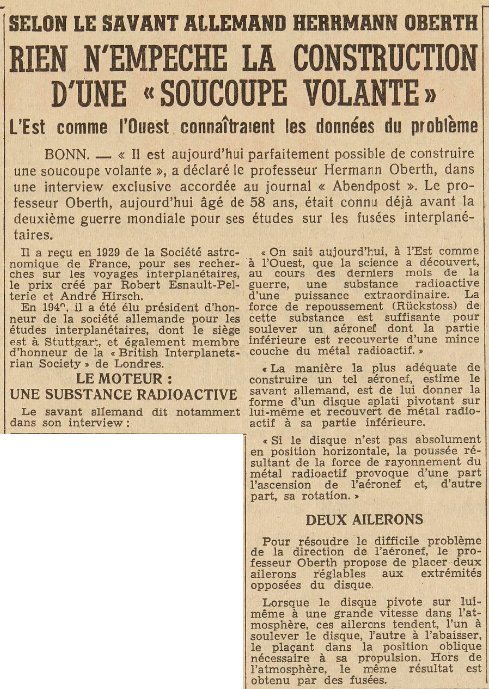The article below was published in the daily newspaper Les Dernières Nouvelles d'Alsace, Strasbourg, France, page 2, on August 21, 1952.

|
BONN. -- "It is perfectly possible today to build a flying saucer," declared Professor Hermann Oberth in an exclusive interview with the newspaper "Abdenpost." Professor Oberth, now 58 years old, was already known before the Second World War for his studies on interplanetary rockets.
In 1929, he received from the French Astronomical Society, for his research on interplanetary travel, the prize created by Robert Esnault-Pelterie and André Hirsch.
In 1949, he was elected honorary president of the German Society for Interplanetary Studies, headquartered in Stuttgart, and also honorary member of the "British Interplanetary Society" in London.
The German scientist stated in his interview:
"It is now known, both in the East and in the West, that science discovered during the last months of the war a radioactive substance of extraordinary power. The repulsion force (Rückstoss) of this substance is sufficient to lift an aircraft whose underside is coated with a thin layer of the radioactive metal."
"The most suitable way to construct such an aircraft," the German scientist believes, "is to give it the shape of a flattened disk that rotates on itself and is coated with radioactive metal on its underside."
"If the disk is not in a perfectly horizontal position, the thrust resulting from the radiation force of the radioactive metal causes both the ascent of the aircraft and its rotation."
To solve the difficult problem of controlling the aircraft's direction, Professor Oberth proposes placing two adjustable ailerons at opposite ends of the disk.
When the disk spins rapidly in the atmosphere, these ailerons cause one side of the disk to rise and the other to lower, tilting it into the oblique position necessary for propulsion. Outside the atmosphere, the same result is achieved using rockets.